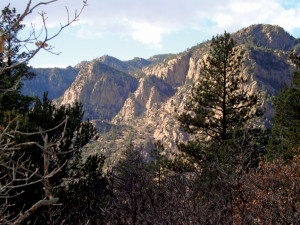Snowpack and Drought
“Spring is an incredibly important time of year for Colorado’s water supplies,” observed State Climatologist Nolan Doesken in a March 18 press release from Colorado State University. He was commenting on the dryness of the soil and forests across Colorado while watching the smoke from a rare wintertime forest fire west of Fort Collins. He also expressed hope that early March moisture was the harbinger of a wet spring.
The entire state was (and still is) in one stage of drought or another, according to the U.S. Drought Monitor. The hardest hit areas are located in the San Luis Valley and the southeastern plains.
March snowpack numbers, as a percent of average, for Central Colorado were in the high 70 percent range (Arkansas, Gunnison and Rio Grande basins) – a double-digit increase over early January reports.
As it turns out Doesken’s hopes were realized, and Colorado was favored by the jet stream during March and April. As we go to press the northern half of the state is approaching or has accumulated average snowpack. Gunnison Basin snowpack is up to 85 percent of average and the Arkansas Basin stands at 77 percent. The Rio Grande Basin snowpack is the lowest in the state at 67 percent of average and has already started melting out for the year.
The Mountain Mail reported on April 19, “SNOTel data from upper (Arkansas) basin sites indicate significant snowpack gains during April. Fremont Pass snowpack reached 68 inches Thursday, up from 49 inches April 2. The Brumley SNOTel site southwest of Leadville shows a snow depth of 35 inches Thursday, compared to 26 inches April 2.”
That is good economic news. Whitewater sports are a big business along the main stem of the Arkansas River above Pueblo Reservoir, and rafting numbers were down in 2012. Outfitters keep a close eye on snowpack, not only in the Arkansas Basin but also in the Colorado River Basin, where transmountain diversions bring water from the Roaring Fork, Eagle and Fryingpan basins to quench the thirst of farmers and cities.
The improved snowpack has everyone breathing easier about the upcoming boating and angling season along the Arkansas. A press release from the Arkansas Headwaters Recreation Area on April 18 stated:
“Not only will there be a good spring runoff, but the late season snowstorms also increase the possibility of a successful flow program for the multi-agency Voluntary Flow Management Program (VFMP). The VFMP maintains minimum flows for the fishery throughout the year and provides enhanced flows for rafting and kayaking from July 1 through mid-August. ‘In a year like this, we potentially have the best of both worlds; the fishery on the Arkansas River is the best it’s been in years due to low flows last season, while the late season addition to the snowpack promises to provide an abundance of whitewater,’ said Rob White, AHRA Park Manager.”
Economic news is not as good over in the South Platte Basin. Park County officials are worried about the effects of the drought on angling.
For example, Denver Water plans to drain Antero Reservoir starting in May, moving the water downstream to Cheesman and Eleven Mile Reservoirs to lessen the impact of evaporation and move the water closer to their service area.
The Fairplay Flume reports, “(Fishing guide Michael Egloff) takes people flyfishing, and Antero has been one of his popular spots. The fish produced in that reservoir were always bigger, and it was always a popular spot for everyone. ‘People come from all around to fish at Antero. It’s going to hurt everything up here,’ Egloff said.”
Aurora’s Spinney Mountain Reservoir boat ramps are high and dry with no expectations that the reservoir will fill.
Forest Service Begins Public Meetings About Their Permit Water Rights Clause
The USFS is conducting the meetings as a result of being on the losing side of a lawsuit brought by the National Ski Areas Association. The lawsuit was prompted by a clause in ski area permits that required ski ares to turn over water rights to the U.S. government as a permit condition. In December The Denver Post reported, “Judge William Martinez ruled that the Forest Service’s revision of 2011 and 2012 permit regulations governing water rights violated federal procedural rules, failed to evaluate economic impact and violated ski area rights.”
The NSAA is arguing that in Colorado, water rights are a private property right granted by the state and that the USFS permit requirement constitutes an unlawful taking by the federal government. The USFS says that the viability of a ski area often depends on water for snowmaking and other uses, and that they are only attempting to protect the business model and the public interest. (See the April and December 2012 issues of Colorado Central for more background.)
“There is a fundamental difference of opinion that will be hard to overcome,” said Jim Pena, the Forest Service’s acting deputy chief, according to The Denver Post.
“‘We are excited about having ideas and offering something new,’ said the association’s public policy director Geraldine Link, who led the industry’s lawsuit to overturn the water clause. ‘We are staying let’s start over. We think there is a way to address Forest Service concerns without the seizure of assets,’” according to The Denver Post.
Also from The Denver Post, “‘Without long-term assurances for water, we feel we could be putting the public’s interest at risk,’ (Pena) said. ‘The whole idea of sustainability is about preserving resources for future generations. We are seeing more of the ski industry being managed by corporate interests.’”
Not all ski area operators are on board with the NSAA. The Post reports that the Wolf Creek Ski Area shared water rights with the USFS when they renewed their permit in 2000. Davey Pitcher, owner of the area, told The Post, “We don’t see a problem. We see it as a reasonable request.”
The USFS plans to prepare a new water clause in May after the current hearings, solicit public input over the summer and issue a final ruling in August.
Short Takes
• Outfitter Reed Dils has stepped down from the Southeastern Colorado Water Conservancy District board and will be replaced by Salida City Councilor Jay Moore.
• On April 12, San Luis Valley favorite son Ken Salazar posted a goodbye on his Twitter feed (@KenSalazar), “Today is my last day as Secretary of the @Interior. Thank you to everyone. It has truly been a joyful journey.”
• Another Coloradan, Harris Sherman, is also leaving the Interior and his role at the USFS.
• The National Park Service reports that the Curecanti Recreation Area and Black Canyon generate $50 million in economic activity each year.
• More than 4,000 feet of stream bank has been restored so far on Kerber Creek.
• The Colorado River was named the most endangered river in the U.S. for 2013 by American Rivers.
• As we go to press, a bill (HB13-144) proposed by State Rep. Randy Fischer that would allow capture and reuse of greywater has passed the state House and is expected to pass in the state Senate.
John Orr covers water issues at his weblog, Coyote Gulch, http://coyotegulch.net/. For those that say water flows uphill to money John adds the corollary: “In Colorado you are never out of water until you are out of money.”



